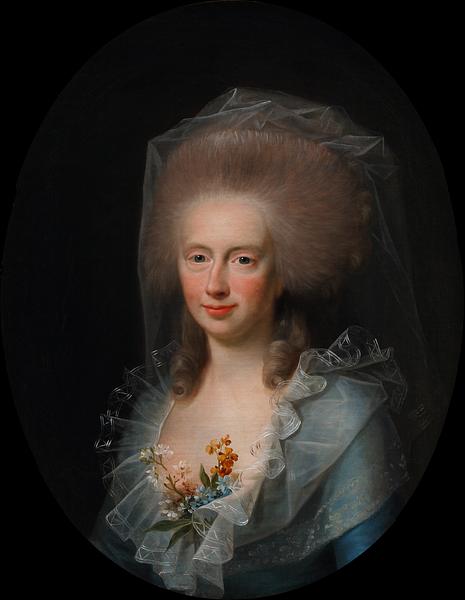The portrait of Bolette Marie Lindencrone (1750–1800) was painted at a time when Jens Juel particularly favoured the oval format. True to his signature style, he shows his model from the front, slightly turned. The light falls evenly on the face, which is finished with great care and detail, while the background is completely neutral. In addition, Juel’s approach to his chosen subject is straightforward and natural – a typical trait of the painter in the 1780s, when he was repeatedly praised for his portraiture. The portrait of Bolette Marie Lindencrone was executed concurrently with its pendant, the portrait of her husband (
B 354), specifically during the period 24 to 29 June 1787. We know this because Johan Frederik Lindencrone makes a diary entry stating that the portrait of his wife is ‘an exceedingly good likeness’.
[1]Bolette Marie Lindencrone is depicted with her hair arranged in an upswept hairdo and with long ringlets along her neck. A transparent veil has been pulled back to rest on the hair. The light blue dress has a plunging neckline, and above the dress is a delicate, transparent cape with a pattern along the edge. At the bottom is a relatively simple bouquet of flowers – in the eighteenth century, finery and adornment meant
everything to ladies of a certain standing.
Johan Frederik and Bolette Marie Lindencrone were married in 1768 and had six children together. Only one child, a daughter, reached adulthood, and she later married into the surname Hegermann. Bolette Marie Lindencrone is thus the progenitor of the Hegermann-Lindencrone family, where amongst others the porcelain painter Effie Hegermann-Lindencrone (
MK 22) is found. Even more works in The David Collection relate directly to the Lindencrone family: the museum owns several examples of Chinese export wares from circa 1739–1741 (
22/1970 and
51/1978), which originate from Bolette Marie's father-in-law, supercargo for the Danish Asiatic Company, Christen Lintrup (1703–1777).
